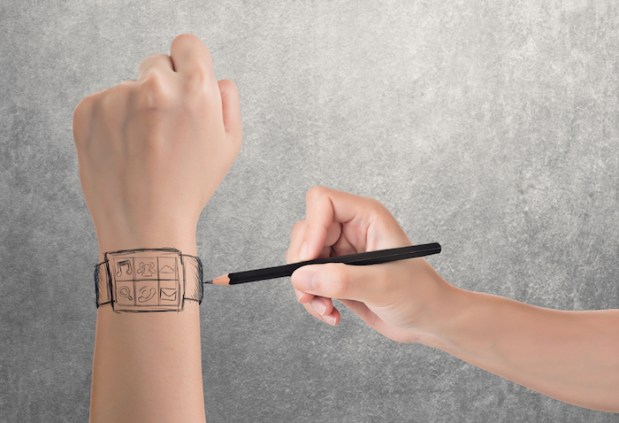The Way Forward For Wearables

Wearables are at an interesting crossroads in the life of the American consumer.
From the biggest names in retail and technology to up-and-coming startups, there suddenly seems to be a world of innovators with wearable inventions at the ready to make all of our collective lives better.
Just since the start of September, we’ve seen the latest super-specialized connected fitness product out of Garmin, the latest edition of the Apple Watch, Fitbit’s Ionic, Samsung’s partnership with Speedo on the newly released Gear Sport line, rumors that Amazon will release smart specs of its own and (perhaps our favorite) the smart denim jacket collaboration between Google and Levi’s.
And those were just the big headlines.
“There is plenty of room for many to be successful,” Tavis McCourt, an analyst with Raymond James, noted in early September.
That’s the glass-half-full outlook for wearables. The glass-half-empty side of the coin observes that for all the excitement, wearables as a category have struggled to gain a committed following.
Think back a few short years to the first heavily hyped wearable by a major player, Google Glass. In January of 2014, analysts were predicting that it was the next big thing – move over, iPhone. A year later, the project was officially shelved as a valuable learning experience.
That pattern has repeated itself with many wearables thus far, with enthusiasm among actual consumers notably trailing the hype. This year, 2017 has been a rough one for wearables; Fitbit has shed more than 70 percent of its value this year alone, Intel closed the doors on its wearables unit and Jawbone – a much-loved darling of Silicon Valley – liquidated its assets.
So, with much expected but not quite so much delivered, the obvious question is perhaps: What is the way forward for wearables?
Why Woo the Wearable Consumer at All?
To answer that question, one first needs to understand the wearable consumer.
Consumers who buy wearables, according to our research, seem rather keenly dissatisfied with their commerce experience today. They tend to view connected devices, broadly, as a way to turn that frown upside down. They’re on the go, not surprising, and like to shop online. When they shop, they spend more: They purchase more stuff in a week than their non-wearable owning counterparts, particularly when it comes to personal care products, health care goods, medication and travel items. Using cash does not seem to float their boat.
Wearables owners also have lots more connected devices than the average bear (5.5 to be precise) and want to use those devices to enable payments and commerce experiences inside while they’re doing other things – such as cooking, walking the dog, taking care of the kids, commuting and just generally being on the go.
All of this might offer some clues as to the way forward for wearables, and the place that payments may play.
What’s Next
Serious fitness buffs seem to flock to Garmin wearables despite their rather high price tag and a near-universal observation that its screen is fairly “blah.”
It may be blah, but like an e-ink reader, it’s easy to read in bright sunlight and loaded with some very custom fitness apps that go way beyond “just counting steps, and enabling people to work out,” noted one Garmin enthusiast.
Including payments. Garmin Pay now enables its users to contextualize their commerce experiences when they are on the go at merchants where NFC is accepted. And although Garmin users may not have been prompted to buy its new watch for payments, embedding payments as a feature creates a new commerce experience that wearables consumers say they’d like to explore. The same holds true for the new Fitbit Ionic.
Amazon has reportedly hired much of the former Google Glass team to work on its version of a wearable. But other than the camera and various design features that seemed to turn people off, what we have seen of Amazon’s design so far seems to be Warby Parker meets Alexa: a fairly normal-looking pair of specs, with a built-in microphone that connects to an app on a smartphone and lets users talk to Alexa remotely.
Whether that use case is compelling enough to get users to buy Alexa-powered specs will be determined by, among other things, how hip and happening the glasses are and whether they solve a problem that the consumer really has without introducing undue friction in the process.
Or there’s the new jean jacket from Levi’s and Google that (care of a smart tag and some high-tech fibers) makes it possible for consumers to keep their phones in their pockets while still navigating it through some easy swipes on or over their sleeve. Helpful for an on-the-go consumer – say, riding a bike – who would rather not have to look at or handle their phone. Could that consumer also eventually want a jacket that allows them to pay with a swipe? Seems possible enough, as those types of buyers like saving time and minimizing hassle.
But why is the consumer buying it first and foremost? It looks cool, and makes it somewhat easier to navigate technology hands-free.
For a less “big business” example, consider the Opter Life, a simple, aesthetically appealing bamboo pendant necklace. Its smart functions are numerous – it reminds users to adjust their posture (helpful for those of us who spend our time bent over computer screens) and apply sunscreen – but above all, it looks nice.
And so that’s the path forward for wearables and the ignition problem that has eluded them so far: Solve a real consumer problem, first, and then identify the use cases that can be brought to life, seamlessly, when commerce is introduced.
